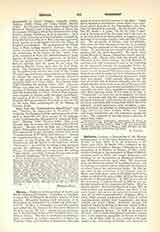

Gerbet, OLYMPE-PHILIPPE, a French bishop and writer; b. at Poligny (Jura), 1798; d. at Perpignan (Pyrenees Orientales), 1864. He studied at the Academie and the Grand-Seminaire of Besancon, also at St-Sulpice and the Borbonne. Ordained priest in 1822, he joined Lamennais at “La Chesnaie” (1825) after a few years spent with Salinis at the Lycee Henri IV. Although an enthusiastic admirer of Lamennais he nevertheless accepted the papal Encyclical “Mirari vos” of August 15, 1832, and the “Singulari nos” of July 13, 1834, which condemned the traditionalism of Lamennai; and, after fruitless afforts to convert the master, he withdrew to the “College de Juilly” (I 36). The years 18 9 he spent in Rome, gathering data for his “Esquisse de Rome Chretienne”. Recalled by Monseigneur Sibour, he became successively professor of sacred eloquence at the Sorbonne, Vicar-General of Amiens, and Bishop of Perpignan (1854). His episcopate was marked by the holding of a synod (1865), the reorganization of clerical studies, various religious foundations, and, above all, by the famous pastoral instruction of 1860 sur diverses erreurs du temps present, which served as a model for the Syllabus of Pius IX. Gerbet has been called the Fenelon of the nineteenth century. Besides many articles in “Le Memorial catholique”, “L’Avenir”, “L’Universite catholique”, and some philosophical writings (“Des doctrines philosophiques sur la certitude”, Paris, 1826; “Sommaire des connaissances humaines”, Paris, 1829; “Coup d’oeil sur la controverse ohretienne”, Paris, 1831; “Precis d’histoire de la philosophic”, Paris, 1834: under the names of Salinis and Scorbiac), all more or less tinctured with Lamennais’s errors, he wrote the following: “Considerations sur le dogme generateur de la piete chretienne” (Paris, 1829); “Vues sur la Penitence” (Paris, 1836)—these two works are often published together; “Esquisse de Rome Chretienne” (Paris, 1843), previously mentioned. In the two former books Gerbet views the dogmas of the Eucharist and Penance as admirably fitted to develop the affections—nourrir le occur de sentiments—just as he uses the realites visibles of Rome as symbols of her essence spirituelle. Sainte-Beuve (Causeries de lundi, VI, 316) says that certain passages of Gerbet’s writings “are among the most beautiful and suave pages that ever honored religious literature”. Gerbet’s “Mandements et instructions pastorales” were published at Paris in 1876.
J. F. SOLLIER

